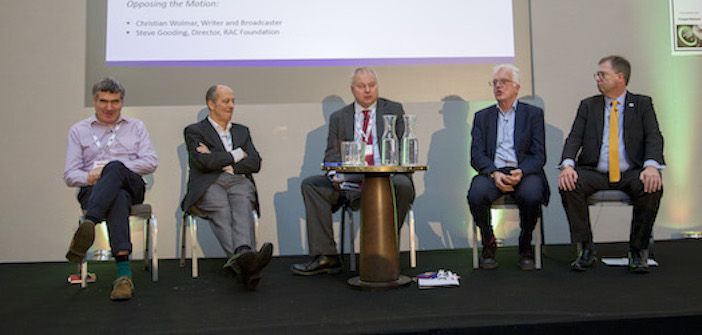A hotly-contested formal debate about autonomous vehicles (AVs) provided an entertaining centrepiece to ITS (UK)’s inaugural Summit in Bristol this week (November 27), with those arguing against pointing to disingenuous business models, flawed safety improvement predictions, and unachievable congestion-reduction targets, as reasons to be wary of the drive toward AV deployment.
Andy Graham, chair of the ITS (UK) Connected and Autonomous Vehicles Forum, invited speakers on both sides to address the following motion: This House believes that driverless cars are the biggest opportunity for a step change in mobility and therefore it is right that resources and investment are channelled towards them.
“We are on the cusp of a mobility revolution,” said proposer Giles Perkins (above), technical director of future mobility at WSP. “The arrival of AVs will be as significant as the arrival of the internet, becoming an intrinsic part of people’s lives. They will provide new models of public and shared transport. They will provide the backbone of freight and logistics networks serving an expanding population.” AVs will catalyse a decline in private car ownership, allow people to perform productive work rather than driving and eliminate fatalities attendant on human error, Perkins argued – making them ‘a force for good.’
“Not a shred of evidence!” was the riposte from writer and broadcaster Christian Wolmar (above), who likened the proposed future of connected vehicles to characters in children’s comic books, wearing helmets with propellers. Level 3 autonomy actually creates a deterioration in safety, he said, while the unsubstantiated claim that AVs will reduce congestion was described as “a real joke” and commercially disingenuous. “It’s about a business model where the hype is the business model,” he explained. Some £250 million had been wasted on AV development in the UK, Wolmar said, whereas time and energy would be better expended on “Small things that will make a real difference”– like designing effective cycle lanes
Tony Pipe (above), deputy director of the Bristol Robotics Laboratory, drew a parallel between Wolmar’s position and climate-change denial, since both decry the lack of evidence for something which has yet to happen. “Over 90% of accidents are due to the driver not paying attention,” said Pipe. “AVs have the potential to greatly reduce that. We only have one set of eyes; AVs have 360° vision at all times and response times which are 10 times faster.” Their first use, he argued, would be in cargo transportation, while “breaking down the lock of car ownership” would be among their longer-term benefits.
“The government’s enthusiasm for AVs is a distraction from Brexit,” joked RAC Foundation director Steve Gooding (above). “They provide the biggest opportunity for a step change – for the worse!” He raised the question of how a transitional, mixed-economy with both AVs and human drivers on the roads would function, suggesting that AVs would have to operate on tightly geo-fenced networks. Money would be better spent resolving such unanswered questions, he said, than on the technology itself. “The government has a bold ambition to make the UK the testbed of choice for AVs,” Gooding memorably concluded, “which is like making Easter Island the testing ground of choice for nuclear weapons.”
The subsequent debate swung back and forth. Perkins emphasised the potential of AVs to reduce single-occupancy driving, while Wolmar suggested that the proposed on-demand model had not been properly thought out, because “you’ve got to send an empty back.” Perkins stressed the likely alignment of AVs with vehicle electrification, bringing environmental advantages and reducing maintenance needs.
Wolmar continued to hold the floor, questioning Perkins’ earlier claim that AVs would lead to improved land use and a reduced need for parking. Citing recent press coverage, he hinted at an authoritarian dimension to the issue, with tech companies lobbying governments to ban pedestrianism and cycling as being retrograde to AV operations. “We’re going to have to adapt to a world in which driverless cars can function,” he said. “To me, that’s dystopian.”
After the summings-up, many delegates were able to vote using an online app. There was a narrow majority in favour of AVs, with 52% supporting the motion and 48% disagreeing. This represented a slight swing from a vote taken prior to the debate, wherein 56% had supported the motion. Following the good-humoured controversy of the debate itself, the closeness of the margin prompted joking comparisons with Britain’s 2016 EU Referendum, which saw a similarly narrow majority of those who took part voting for Britain to leave the EU, based on information available at the time.
It was a lively debate – and one which seems sure to continue in the years ahead.
By Jack Roper





